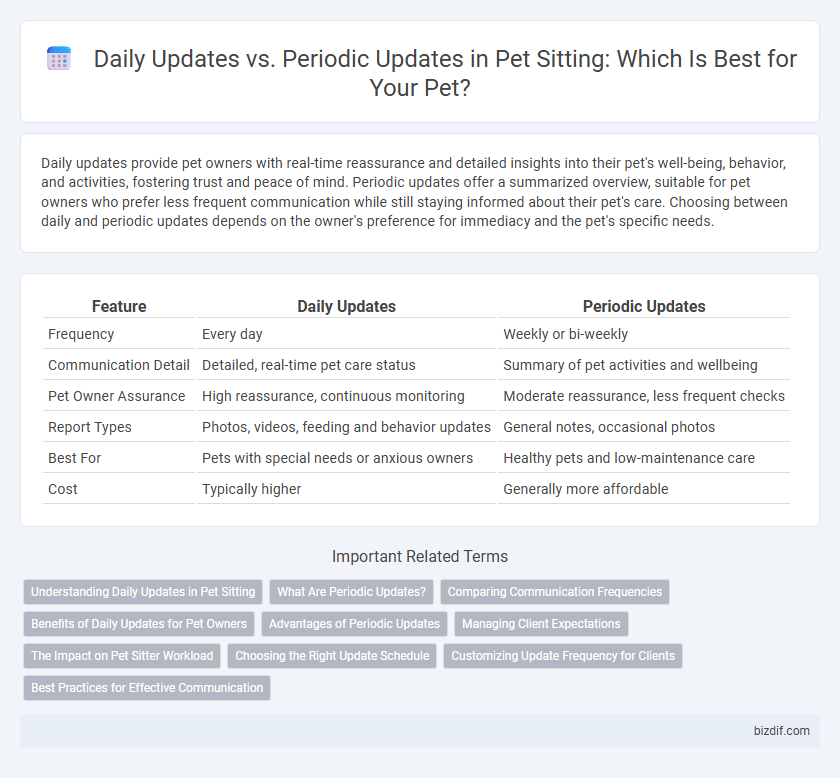Daily updates provide pet owners with real-time reassurance and detailed insights into their pet's well-being, behavior, and activities, fostering trust and peace of mind. Periodic updates offer a summarized overview, suitable for pet owners who prefer less frequent communication while still staying informed about their pet's care. Choosing between daily and periodic updates depends on the owner's preference for immediacy and the pet's specific needs.
Table of Comparison
| Feature | Daily Updates | Periodic Updates |
|---|---|---|
| Frequency | Every day | Weekly or bi-weekly |
| Communication Detail | Detailed, real-time pet care status | Summary of pet activities and wellbeing |
| Pet Owner Assurance | High reassurance, continuous monitoring | Moderate reassurance, less frequent checks |
| Report Types | Photos, videos, feeding and behavior updates | General notes, occasional photos |
| Best For | Pets with special needs or anxious owners | Healthy pets and low-maintenance care |
| Cost | Typically higher | Generally more affordable |
Understanding Daily Updates in Pet Sitting
Daily updates in pet sitting provide real-time insights into a pet's wellbeing, including feeding times, behavior changes, and activity levels, ensuring pet owners remain closely informed. These frequent communications enhance trust and allow for prompt responses to any issues, resulting in improved pet care quality. Regular, detailed daily updates are preferred over periodic summaries for maintaining consistent monitoring and peace of mind.
What Are Periodic Updates?
Periodic updates in pet sitting involve providing pet owners with comprehensive reports at set intervals, such as weekly or biweekly, summarizing their pet's behavior, health, and activities. These updates often include detailed observations, photos, and notes on feeding, exercise, and any changes in mood or medical conditions. This approach ensures pet owners stay informed without the need for constant communication, balancing thorough care documentation with convenience.
Comparing Communication Frequencies
Daily updates in pet sitting ensure real-time information sharing about pets' behavior, health, and activities, offering pet owners continuous peace of mind. Periodic updates, often scheduled every few days, provide a broader overview but may delay responses to urgent needs or changes in pet conditions. Communication frequency directly impacts trust and satisfaction levels, with daily updates fostering stronger client relationships through consistent transparency.
Benefits of Daily Updates for Pet Owners
Daily updates provide pet owners with real-time insight into their pet's well-being, including behavior, feeding, and activity levels, enhancing peace of mind and trust in the sitter. Frequent communication helps quickly identify any health or mood changes, allowing prompt attention and care adjustments. This consistent transparency builds a stronger bond between owners, pets, and sitters, ensuring a tailored and responsive pet sitting experience.
Advantages of Periodic Updates
Periodic updates in pet sitting offer comprehensive summaries of a pet's well-being, providing pet owners with detailed insights on behavior, diet, and activity trends over a set timeframe. These updates reduce communication fatigue while ensuring critical information is systematically shared, enhancing trust and transparency. Veterinary professionals and pet owners benefit from periodic documentation when monitoring long-term health patterns and adjusting care plans.
Managing Client Expectations
Daily updates provide pet owners with real-time reassurance through frequent photos and messages, enhancing trust and transparency. Periodic updates balance time efficiency with communication, suitable for clients preferring less frequent but comprehensive reports. Clearly outlining update frequency during initial consultations helps manage client expectations and ensures satisfaction.
The Impact on Pet Sitter Workload
Daily updates in pet sitting significantly increase the pet sitter's workload by requiring constant attention and frequent communication with pet owners. Periodic updates reduce this strain by allowing the sitter to focus more on pet care tasks without the distraction of frequent reporting. Balancing update frequency ensures pet owners remain informed while maximizing the sitter's efficiency and attention to pets.
Choosing the Right Update Schedule
Choosing the right update schedule for pet sitting depends on the pet's needs and the owner's preferences. Daily updates provide real-time reassurance through photos, videos, and detailed reports, ideal for anxious owners or pets requiring constant attention. Periodic updates, such as every few days, suit low-maintenance pets or owners seeking less frequent communication while ensuring the pet's wellbeing is consistently monitored.
Customizing Update Frequency for Clients
Customizing update frequency for clients in pet sitting enhances communication by offering daily updates for pet owners seeking real-time information and peace of mind. Periodic updates, sent weekly or bi-weekly, cater to clients who prefer less frequent but comprehensive summaries of their pet's activities and well-being. Tailoring update schedules based on client preferences improves satisfaction and trust by aligning with individual needs and lifestyle demands.
Best Practices for Effective Communication
Daily updates in pet sitting provide real-time information on pets' health, behavior, and activities, ensuring pet owners remain informed and reassured. Periodic updates, while less frequent, can consolidate observations to highlight trends or concerns over time. Best practices for effective communication include consistency, clarity, and personalized content tailored to the pet owner's preferences and the pet's specific needs.
Daily updates vs Periodic updates Infographic

 bizdif.com
bizdif.com